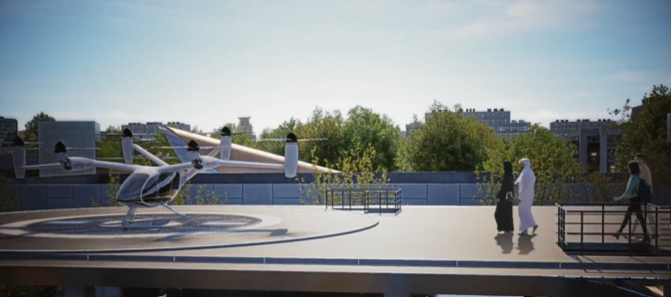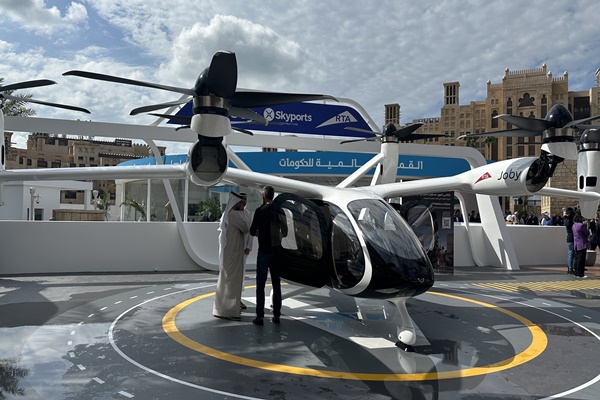In an ambitious move toward futuristic, eco-friendly urban transportation, Dubai has officially approved its first aerial taxi vertiport, aiming for a grand debut in 2026. As a city renowned for its innovation, Dubai’s approval of the aerial taxi vertiport signals an exciting advancement in urban mobility, promising to redefine how residents and tourists navigate the skyline. This article explores the details of Dubai’s first aerial taxi vertiport, the technology behind it, and the broader impact of this pioneering project on the city’s transportation ecosystem.
Image Source>>joby aviation
The Vision Behind Dubai’s First Aerial Taxi Vertiport
Dubai has always been synonymous with technological innovation and futuristic infrastructure. The aerial taxi vertiport is an extension of this commitment, offering a sustainable alternative to traditional road transportation. The initiative forms part of Dubai’s wider vision to reduce carbon emissions, alleviate traffic congestion, and increase urban connectivity by integrating a network of vertiports around the city, thereby transforming daily commutes into rapid, scenic flights above Dubai’s iconic skyline.
How Aerial Taxis Will Operate in Dubai
Dubai’s aerial taxis will utilize the vertiport infrastructure to take off and land vertically, eliminating the need for expansive runways. These aerial taxis, designed to be electric and autonomous, will fly passengers between designated vertiports, which are strategically located across the city to serve as convenient access points for commuters.
This system aims to facilitate easy transfers between critical areas, such as downtown Dubai, the marina, and major transport hubs like Dubai International Airport. The seamless, automated process means that passengers will simply book their flights, board the aerial taxi at a nearby vertiport, and be transported to their destination with minimal time on the ground.
What Is an Aerial Taxi Vertiport?
A vertiport is a specialized terminal for electric Vertical Take-Off and Landing (eVTOL) aircraft, such as aerial taxis. Equipped with charging stations, safety systems, and passenger amenities, vertiports are the foundational infrastructure enabling urban air mobility (UAM). Dubai’s first vertiport is designed to accommodate multiple eVTOL aircraft, ensuring a steady flow of aerial taxis for passengers at any time.
Unlike traditional airports, vertiports occupy a much smaller footprint, which allows them to be situated in urban areas. This flexibility in location not only enhances accessibility but also positions vertiports as integral parts of Dubai’s urban landscape, blending seamlessly into high-rise complexes, shopping centers, and major commercial districts.
Features of Dubai’s Aerial Taxi Vertiport
The vertiport in Dubai will include several essential features:
- Electric charging stations to keep eVTOL vehicles ready for continuous operations.
- Passenger lounges that provide a comfortable waiting area.
- Advanced navigation and communication systems to coordinate safe takeoffs and landings.
- Security checkpoints and AI-driven safety protocols to ensure passenger safety and privacy.
Dubai Approves First Aerial Taxi Vertiport: Key Milestones

Image Source>>msn
The approval of Dubai’s first aerial taxi vertiport follows years of planning and collaboration between Dubai’s Roads and Transport Authority (RTA) and global leaders in eVTOL technology.
The 2026 Launch: What to Expect
Dubai’s Roads and Transport Authority aims to operationalize the vertiport by 2026, with a focus on connecting primary locations. This ambitious timeline underscores Dubai’s commitment to positioning itself as a global leader in the aerial mobility space.
Dubai’s aerial taxis, powered by advanced eVTOL technology, promise zero-emission flights that are quiet, efficient, and fully autonomous. The RTA expects the vertiport to serve thousands of passengers in its initial phase, paving the way for a broader rollout across the city.
The Technology Behind Aerial Taxis

Aerial taxis rely on eVTOL technology, which enables vertical takeoffs and landings, allowing them to operate in densely populated urban areas without the need for extensive infrastructure. Here are some technological aspects driving the development of Dubai’s aerial taxis:
Electric Propulsion Systems
Unlike helicopters, eVTOLs are powered by electric propulsion, which makes them quieter, more efficient, and environmentally friendly. Electric propulsion ensures that aerial taxis produce zero emissions, aligning with Dubai’s sustainability goals.
Autonomous Navigation Systems
Equipped with advanced sensors and AI-driven navigation systems, aerial taxis in Dubai will operate autonomously, providing a seamless, driverless experience for passengers. This technology enables real-time adaptation to weather conditions, air traffic, and safety protocols, ensuring a smooth journey from one vertiport to another.
High-Density Lithium Batteries
One of the key components of eVTOL technology is its high-density lithium batteries, which power the aerial taxis for sustained flights. These batteries offer sufficient power for multiple short-haul trips, allowing for efficient recharges between flights at vertiports.
Dubai First Aerial Taxi Vertiport 2026: Enhancing Urban Mobility

By 2026, Dubai’s first aerial taxi vertiport aims to offer commuters an alternative mode of transportation, revolutionizing how people move around the city.
Reducing Road Congestion
With an expanding population and high tourist inflow, Dubai’s roads often experience congestion. Aerial taxis provide a solution by diverting a portion of commuters into the sky, freeing up space on the ground.
Lowering Carbon Footprint
Traditional road-based transport relies heavily on fossil fuels, contributing to carbon emissions. Aerial taxis, on the other hand, are fully electric, producing zero emissions. With Dubai’s aerial taxi vertiports, the city aligns closer to its vision of becoming a global green economy.
Efficient Time Management for Passengers
For business professionals, tourists, and residents alike, the aerial taxi service will offer substantial time savings. Short trips that would typically take up to an hour by car can be completed in a matter of minutes with aerial taxis, allowing passengers to make the most of their time.
Regulatory and Safety Considerations

Dubai’s move toward aerial mobility comes with a comprehensive regulatory framework to ensure public safety. The Roads and Transport Authority (RTA) is working closely with regulatory bodies to develop stringent guidelines for the operation of aerial taxis, including:
- Passenger Safety Standards: Compliance with international safety standards and local regulations will be strictly enforced.
- Privacy Measures: As autonomous technology is integral to aerial taxis, robust privacy protocols are in place to protect passenger data.
- Emergency Response Systems: The vertiports will be equipped with advanced emergency response mechanisms to handle any in-flight or landing issues.
FAQs on Aerial Taxi Vertiport Dubai
What is Dubai’s first aerial taxi vertiport?
Dubai’s first aerial taxi vertiport is a designated terminal for aerial taxis, using eVTOL technology to provide rapid, eco-friendly transportation between key areas in the city.
When will Dubai’s first aerial taxi vertiport be operational?
The first vertiport is slated to open by 2026, offering a new transportation mode for Dubai residents and visitors.
How will aerial taxis impact traffic in Dubai?
By shifting a portion of ground-based commuters into the air, aerial taxis will reduce road congestion and contribute to smoother traffic flow.
What makes aerial taxis environmentally friendly?
Aerial taxis are powered by electric propulsion systems, producing zero emissions, aligning with Dubai’s environmental goals.
Will aerial taxis in Dubai be autonomous?
Yes, Dubai’s aerial taxis will utilize autonomous navigation systems, ensuring a driverless, efficient experience for passengers.
Are aerial taxis safe to use?
Aerial taxis undergo rigorous testing and comply with international safety standards, ensuring a high level of passenger safety.
The Future of Aerial Mobility in Dubai

Image Source>>Travels Dubai
As Dubai approaches the anticipated 2026 launch date, the city is already setting a global benchmark for integrating aerial taxis within an urban setting. The success of Dubai’s first aerial taxi vertiport could lay the foundation for more widespread use of eVTOL technology across other global cities facing congestion challenges.
Dubai’s investment in aerial taxis reflects its commitment to advancing transportation in line with sustainable goals, positioning the city as a leader in modern, environmentally friendly mobility solutions. As aerial taxis become an everyday sight in the city’s skyline, Dubai is not only transforming its urban landscape but also inspiring a shift in how people around the world think about urban travel.




